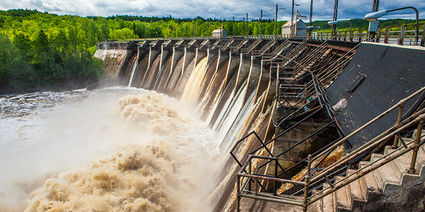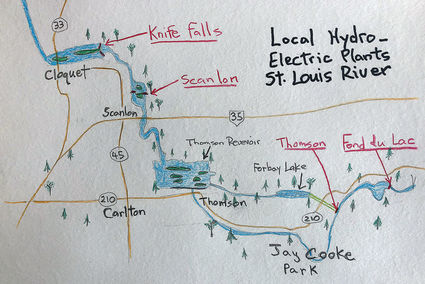LOOK AT THAT! Behold the power of the St. Louis River
November 15, 2019
Spending time in Carlton, Cloquet, Thomson and Jay Cooke State Park is sure to reveal a few sites of interest for sure.
I like to paddle the St. Louis River from Scanlon to the Thomson Reservoir on warmer days than today. During the journey we get to run, or portage, a famous drop called "electric ledge." When approaching this drop, you can't miss how it got its name: not from the electricity flowing through my body, but the high power lines that span the river. This beautiful St. Louis River is full of power, power that can hurtle me down current in a kayak and current that can generate electricity that can provide power - electrical current - to run tools, water heaters and light bulbs, among other things.
It all starts with the force of gravity. Gravity causes water to flow downhill. Imagine a world without gravity - our planet wouldn't exist without it. This flowing water is kinetic energy (energy in motion); it can be manipulated to spin magnets creating electric energy. This electric energy can turn motors (kinetic energy), light a bulb (light energy) and run a toaster (heat energy). I would like to dive into hydroelectric generation and electricity in my next column. This column will cover the four local hydroelectric plants, all found within a few miles in our area, on our beloved St. Louis River.
Minnesota Power owns and operates four hydroelectric plants in our neighborhood. You can see the locations of those plants on my fancy drawing below.
Knife Falls plant is the first of the four, built in 1922 at the historic Knife Falls portage, the last portage for the voyageurs leaving for the north country on their way out of the Jay Cooke area. This plant can generate 2.4 megawatts (one million watts) and uses three generators.
Next is the Scanlon plant, just upstream from Scanlon. Built in 1923, it can generate 1.6 megawatts and has four generators.

Fond du Lac hydroelectric dam was constructed in 1924 and has one generator producing 12 megawatts. It uses water stored behind the dam in a reservoir lake that is easily seen from Highway 210 at the east boundary of Jay Cooke State Park. Contributed photo
To find the next plant, you need to ride the river all the way past the hanging bridge and then a bit further. You can see the plant by canoe or kayak from the water only. This is the Thomson hydro plant, and my favorite. I will spend more time there in the next column. The Thomson plant was built in four stages: 1907, 1914, 1918 and 1948. It can generate 72 megawatts and has six generators.
The final stop on our tour of hydro plants is the Fond du Lac plant, near the Duluth neighborhood of Fond du Lac. Fond du Lac hydro was constructed in 1924 and has one generator producing 12 megawatts. This last plant uses the water stored behind a large dam creating a reservoir lake that is easily seen from Highway 210 at the east boundary of Jay Cooke Park.
A fun field trip would be to try and find all four of these plants and see them in person, another way to feel the power of the St. Louis River.
The very curious Fond du Lac Tribal and Community College science tutor Glen Sorenson was Minnesota Teacher of the Year before he retired from teaching science at Proctor High School after 30-plus years. Want more science from Glen? Find his ongoing "What's That?" videos on the FDLTCC Facebook page.








